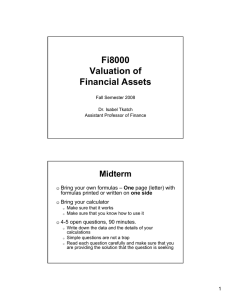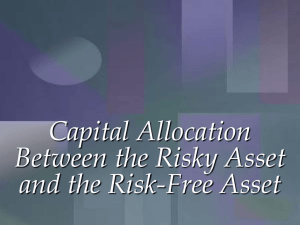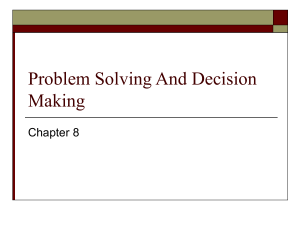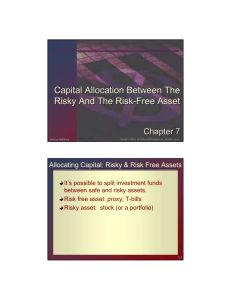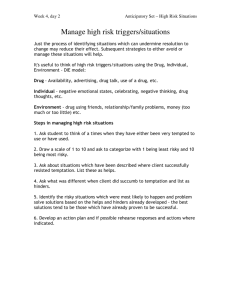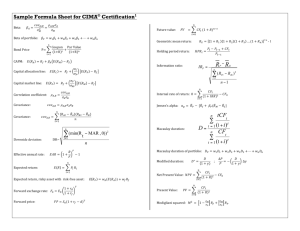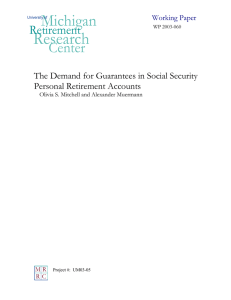Stand Alone analysis
advertisement
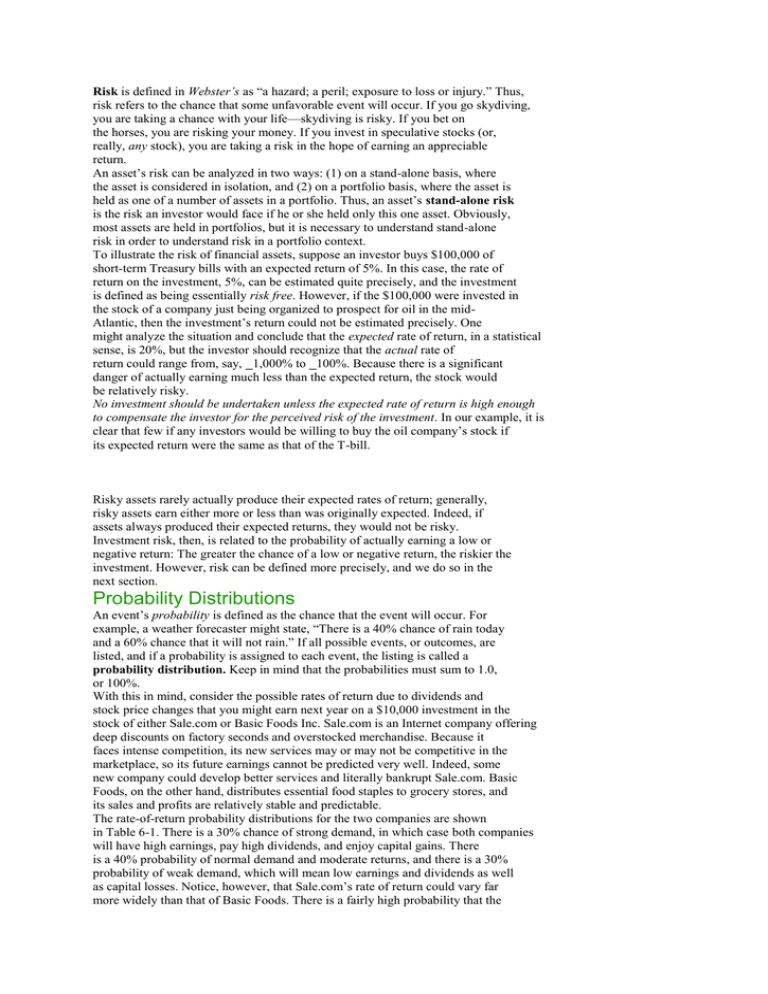
Risk is defined in Webster’s as “a hazard; a peril; exposure to loss or injury.” Thus, risk refers to the chance that some unfavorable event will occur. If you go skydiving, you are taking a chance with your life—skydiving is risky. If you bet on the horses, you are risking your money. If you invest in speculative stocks (or, really, any stock), you are taking a risk in the hope of earning an appreciable return. An asset’s risk can be analyzed in two ways: (1) on a stand-alone basis, where the asset is considered in isolation, and (2) on a portfolio basis, where the asset is held as one of a number of assets in a portfolio. Thus, an asset’s stand-alone risk is the risk an investor would face if he or she held only this one asset. Obviously, most assets are held in portfolios, but it is necessary to understand stand-alone risk in order to understand risk in a portfolio context. To illustrate the risk of financial assets, suppose an investor buys $100,000 of short-term Treasury bills with an expected return of 5%. In this case, the rate of return on the investment, 5%, can be estimated quite precisely, and the investment is defined as being essentially risk free. However, if the $100,000 were invested in the stock of a company just being organized to prospect for oil in the midAtlantic, then the investment’s return could not be estimated precisely. One might analyze the situation and conclude that the expected rate of return, in a statistical sense, is 20%, but the investor should recognize that the actual rate of return could range from, say, _1,000% to _100%. Because there is a significant danger of actually earning much less than the expected return, the stock would be relatively risky. No investment should be undertaken unless the expected rate of return is high enough to compensate the investor for the perceived risk of the investment. In our example, it is clear that few if any investors would be willing to buy the oil company’s stock if its expected return were the same as that of the T-bill. Risky assets rarely actually produce their expected rates of return; generally, risky assets earn either more or less than was originally expected. Indeed, if assets always produced their expected returns, they would not be risky. Investment risk, then, is related to the probability of actually earning a low or negative return: The greater the chance of a low or negative return, the riskier the investment. However, risk can be defined more precisely, and we do so in the next section. Probability Distributions An event’s probability is defined as the chance that the event will occur. For example, a weather forecaster might state, “There is a 40% chance of rain today and a 60% chance that it will not rain.” If all possible events, or outcomes, are listed, and if a probability is assigned to each event, the listing is called a probability distribution. Keep in mind that the probabilities must sum to 1.0, or 100%. With this in mind, consider the possible rates of return due to dividends and stock price changes that you might earn next year on a $10,000 investment in the stock of either Sale.com or Basic Foods Inc. Sale.com is an Internet company offering deep discounts on factory seconds and overstocked merchandise. Because it faces intense competition, its new services may or may not be competitive in the marketplace, so its future earnings cannot be predicted very well. Indeed, some new company could develop better services and literally bankrupt Sale.com. Basic Foods, on the other hand, distributes essential food staples to grocery stores, and its sales and profits are relatively stable and predictable. The rate-of-return probability distributions for the two companies are shown in Table 6-1. There is a 30% chance of strong demand, in which case both companies will have high earnings, pay high dividends, and enjoy capital gains. There is a 40% probability of normal demand and moderate returns, and there is a 30% probability of weak demand, which will mean low earnings and dividends as well as capital losses. Notice, however, that Sale.com’s rate of return could vary far more widely than that of Basic Foods. There is a fairly high probability that the value of Sale.com’s stock will drop substantially, resulting in a 70% loss, while there is a much smaller possible loss for Basic Foods. Note that the following discussion of risk applies to all random variables, not just stock returns. Measuring Stand-Alone Risk: The Standard Deviation Risk is a difficult concept to grasp, and a great deal of controversy has surrounded attempts to define and measure it. However, a common definition, and one that is satisfactory for many purposes, is stated in terms of probability distributions such as those presented in Figure 62: The tighter the probability distribution of expected future returns, the smaller the risk of a given investment. According to this definition, Basic Foods is less risky than Sale.com because there is a smaller chance that its actual return will end up far below its expected return. To be most useful, any measure of risk should have a definite value—we need a measure of the tightness of the probability distribution. One such measure is the standard deviation, the symbol for which is _, pronounced “sigma.” The smaller the standard deviation, the tighter the probability distribution, and, accordingly, the less risky the stock. To calculate the standard deviation, we proceed as shown in Table 6-3, taking the following steps:3 1. Calculate the expected rate of return:

